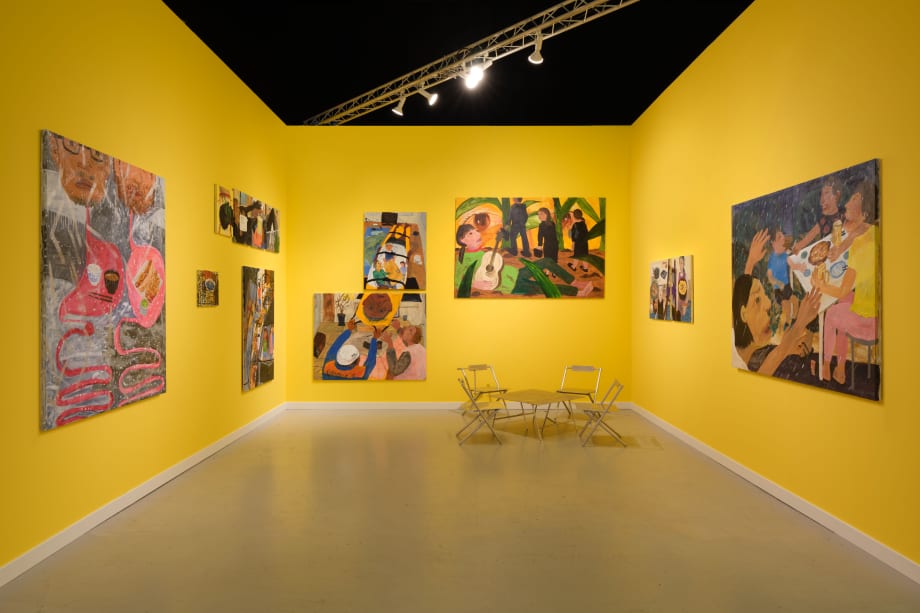Nonaka-Hill is pleased to participate at Frieze Los Angeles 2023, with a solo presentation of paintings by Kyoko Idetsu. The paintings of Kyoko Idetsu emerge from daily life, which is arguably a daisy chain of minor stories. They are inevitably punctuated by more important stories that lodge in our memories and justify our picture frames, resumes, and obituaries; but Idetsu prefers to mostly focus on the smaller ones, anecdotes, elaborating them into paintings with outsized emotional and visual weight. We might call this anecdotal expressionism, a school of painting limited to herself. Or we might describe it as a painting diary, albeit seen through the lens of manga, television, and film; which heightens her ability to jump cut and flashback, to move in time and space across the picture plane. This animates her painted anecdotes, infusing them with unique emotional registers that underlie daily domestic life. And it is not a coincidence that she literally makes her paintings within its sphere––at home––amidst the mild chaos of raising children and tending to routine. One assumes this is partly an economic decision, as many painters are wont to make, but it has significance: as an immersive experience––intended or not––that influences her paintings, at least to a certain degree, into a certain appearance.
Much of this, however, is attributed to her distinctive touch with color, drawing, and composition. She relies heavily on local color (the color of objects under flat white light without shadow or secondary light sources), which entails, for example, that a truck is decidedly cobalt blue and pavement is emphatically grey. She even depicts bicycle spokes with true fidelity––in low-lustre metallic paint. Each object is imbued with a color’s weight and substance, all the while avoiding the optical tricks of realism that would otherwise deaden its immediacy.
If Pierre Bonnard once said that drawing is feeling (and color is reasoning), the same could be said of Idetsu’s use of line and shape. Oriented towards innocent versions of forms, her concerns for traditional perspective and anatomy are laissez-faire––for the exception of compositional structure and harmony, which are, like in all good painting, tightly wound. In her more complex works, they have a kaleidoscopic quality: every object can suddenly open into a vignette and every face can become a projector screen. Which is what transpires in her painting Gaffe, 2022, in which a series of figures float above a reddish face, jointly constructing a story about a woman misspeaking at a local restaurant.
Gaffe might resemble filmic montage as much as other paintings might resemble manga––or both; but either way, these dynamic mechanisms stand in contrast to Idetsu’s quotidian content, which amounts to routine and daily life; and in the thick of routine, days can blend into one another, spawning slight variances of the same stories. Breaking from this cross-fading of minor events, Idetsu focuses on anecdotes that stick out to her, those that are elevated, or become elevated for having been painted. She derives these anecdotes from her personal life or from the news; from books she read; or from a story an acquaintance had shared. Psychotherapist and writer Thomas Moore wrote that storytelling (and retelling), is care for the soul, that “it helps see the themes that circle in our lives.” In visual form, Idetsu does just that, reflecting the unacknowledged care that is invested in our social bonds and in ourselves.
She occasionally supplies these stories, or anecdotes, in writing alongside her paintings (often in the gallery checklist), as if they were appetizers or aperitifs to the viewer’s experience; and they seem to be equally apt for casual conversation amongst her friends and family. Such as the anecdote depicted in Hernia, 2022, in which a local restaurant manager is transported via stretcher to the hospital because of his titular injury. Far from a cataclysm, but unfortunate nonetheless, Idetsu lends it an endearing patina. This is done in part by making the bed sheet a portal into another related story, perhaps the moment in which the tale of injury was told. Yet the heavy lifting is done here, as in all of her paintings, with her unfussy playfulness.
One might even call her style ‘faux-naive,’ but this holds little water when one considers the raft of 20th century artists who set this precedent outside the realm of ‘self-taught’ art: Picasso, Míro, DuBuffet, and Twombly, to name a few, spent the bulk of their careers finding and re-finding that “innocent” place through which they could make things without the baggage and appearance of technical facility. While Idetsu’s paintings do not bare resemblance to these artists, they have a shared commitment to the freedom of unconditioned visual expertise. That is to say, her style commits to what is necessary for her content and emotions. She appears to seek in painting what is found in film, manga, and oral storytelling, while extracting from it the singularity of the medium. In this sense, one might describe her work as pragmatic naïveté, to the extent that naïveté could be applied to the prodigious skill and quality of her painting.
Kyoko Idetsu (b. Japan) lives and works in Tokyo, Japan. Selected solo exhibitions include I want to wear a warm sweater., Bridget Donahue, New York, NY (2022-2023); He had no choice but to do so., Brulee (Shunsuke Imai Studio), Tokyo (2020); Emotion, Art Center Ongoing, Tokyo (2019); Draw me a beautiful picture to hang in my house., LUCKY HAPPY STUDIO, Tokyo (2017); Milky Way, Art Center Ongoing, Tokyo (2017); The Landscape I Saw the Other Day, Art Center Ongoing, Tokyo (2012). Selected group exhibitions include Kyoko Idetsu and Leo Okubo, Lavender Open Chair, Tokyo (2021); Natsuyasumi, Nonaka-Hill, Los Angeles (2021); Fictions of Everyday Life, Akibatamabi 21, Tokyo (2016); TERATOTERA Festival, Tokyo (2015)
FRIEZE LOS ANGELES
Santa Monica Airport The Barker Hanger, February 16 - 19, 2023


